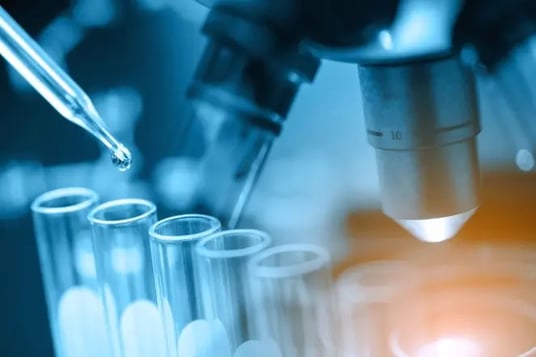Precision medicine focuses on delivering personalized approaches to matching the right patient with the right drug at the right dose and time to optimize treatment impact and patient outcome. Progress in precision medicine has been driven by advances in technology that enable the identification of mutations and characterization of molecular targets. These insights are critical for streamlining the development of novel therapies that are tailored to an individual’s specific disease.
At Precision for Medicine, our translational sciences strategy is built upon three key pillars:
- Supporting complex biomarker research
- Driving a greater understanding of tumor biology
- Driving deeper knowledge of the immune system and its influence on disease
Together, these pillars enable a precision medicine-based approach for successfully addressing complex, immune-driven diseases through the development and applications of biomarkers to support clinical development.
Biomarker-driven strategies have been shown to increase the likelihood of drug approval by approximately 40 percent, which represents both significant patient benefit and potential cost savings.1 To adopt these strategies, clinical design and execution must be fully integrated with a clear biomarker-informed development plan. This requires proactive planning that begins with the end in mind. The ultimate goal is to collect usable samples at informative time points, thus allowing the generation of relevant and actionable data to reduce study timelines and enhance approval success.
Transitioning from Preclinical to Clinical Biomarker Assays
The impact of biomarkers on successful clinical development is increasing. Many biomarkers are initially identified and characterized from preclinical animal models and, as such, will need to be evaluated as suitable for use in the clinical setting. With preclinical animal model assays, fresh blood is usually collected and processed immediately on site. That timeliness results in optimal sample quality and integrity, which results in optimal flow cytometric analysis. In global clinical trials, patient samples from multiple sites are shipped to a sample processing laboratory, so the location of sites and the logistics of transport must be carefully coordinated. In fact, the importance of sample management for appropriate processing and downstream assay analysis cannot be overemphasized.
To be clinically useful and practical, biomarkers must correlate with a clinically relevant endpoint and, ideally, the sample collection should be minimally invasive to the patient. Collecting the right sample type and processing it in the right way for the specific clinical biomarker assay is imperative for generating high quality, actionable data.
Innovators must also consider the characteristics of the assay type:
- For maximum utility, it is best to avoid a highly unique assay platform that may only be available from a single, exclusive lab if the assay is meant to support a global clinical trial.
- Sample type. The need for fresh biosamples increases logistic complexity.
- Number of analytes. For multiplexed, non-targeted assays, sponsors will need a strategy for interpretation of incidental findings when presenting the dataset to regulators.
- Turnaround time. For data that are used to make real-time clinical decisions such as inclusion/exclusion or changes to dose, it is critical to understand how turnaround time may impact feasibility.
- Where biomarker data are used to inform clinical decision-making, appropriate assay validation, perhaps to CLIA, becomes necessary.
Planning Early for How Preclinical Assays Can Be Effective in a Clinical Setting
Preclinical and clinical biomarker teams must work closely together to develop a sound clinical biomarker strategy. Discussion and decisions on assay options, feasibility, development, and validation should occur before clinical collections plans are finalized to avoid having to change study protocols.
To mitigate the loss of clinical samples in the event of logistics issues or delays, it is critical to explore options for stabilizing samples to extend the assay window. This adds a level of protection and maximizes the likelihood of generating the required biomarker data.
Perhaps the most important element of early planning is consideration of how the resulting data will be used, as this will dictate the level of assay validation regulators will require. Assay development and validation can be time-consuming. An unsuitable, poorly validated assay will compromise the intent of precision medicine, as either selecting the wrong patients or not selecting the right patients will weaken the power of a clinical study to demonstrate efficacy in the intended patient population.
Ensuring Sample Quality
Even the best assay will not yield the best data without the highest quality samples. It is vital that both preclinical and clinical samples are of the utmost quality and suitability for the biomarker assay required. In addition to animal models, preclinical human tissue samples are essential for assay development, assay validation, biomarker validation, and clinical proof of concept. These samples may be tissues from non-diseased and diseased donors for insight into biomarker variation, or human primary cell-based models for in vitro characterization of drug effect. When sourcing biospecimens, it is crucial to ensure not only that samples are appropriately consented, but that they are high quality, well-characterized, and available in sufficient numbers.
During clinical trials, samples will be collected at multiple, often global, clinical sites. Typically, there will be many patients, multiple timepoints, and diverse sample formats required for the various downstream biomarker assays required, which may be run at different analytical labs. Given this multifaceted complexity, it is critical to have clear procedures and training in place to ensure that collection, processing, logistics, timing of shipping, sample storage, and assay execution are carefully choreographed. Precision for Medicine has invested in creating an integrated solution for sample management, which is supported by a worldwide lab network and global infrastructure.
Key takeaway
Maintaining engagement between discovery and clinical biomarker and operations teams enables better understanding and planning for translation of preclinical assays to the clinical operations environment. Given the current pace of precision medicine advances, the regulations, and requirements with respect to biomarkers continue to evolve, especially for novel biotherapeutic approaches. Consequently, sponsors need to stay abreast of how regulatory changes may influence or impact their biomarker-informed development plan.
At Precision for Medicine, we provide comprehensive translational science-led research services that deliver biomarker science at scale by bridging bench to bedside. Our end-to-end solution unifies design and delivery of translational and trial solutions to support innovators more efficiently, from concept to commercialization. As a full service CRO, we bring expertise throughout the development process, from study design and execution services to specialty laboratory, sample logistics, biomarker data management, and regulatory and market access capabilities.
Reference
1. BIO, PharmaIntelligence, Quantitative Life Sciences. Clinical Development Success Rates and Contributing Factors 2011-2020. Available at https://pharmaintelligence.informa.com/~/media/informa-shop-window/pharma/2021/files/reports/2021-clinical-development-success-rates-2011-2020-v17.pdf.




